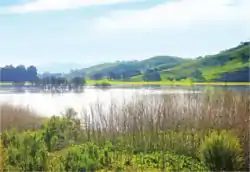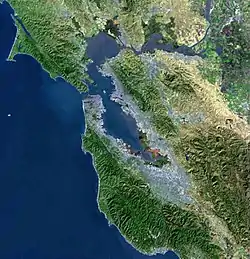Fisher Creek
Fisher Creek is a 13.8 miles (22.2 km) stream that flows northwesterly through the Coyote Valley in southern Santa Clara County, California, United States. It is tributary to the largest freshwater wetland in Santa Clara County, Laguna Seca, a seasonal lake important to groundwater recharge.[2] From Laguna Seca, Fisher Creek was connected to Coyote Creek by an artificial channel.
| Fisher Creek | |
|---|---|
 Laguna Seca in Spring, 2017 | |
| Location | |
| Country | United States |
| State | California |
| Region | Santa Clara County |
| Cities | Morgan Hill, Coyote |
| Physical characteristics | |
| Source | |
| • location | Morgan Hill |
| • coordinates | 37°08′36″N 121°39′56″W[1] |
| • elevation | 351 ft (107 m) |
| Mouth | Coyote Creek |
• location | Coyote |
• coordinates | 37°13′28″N 121°44′51″W[1] |
• elevation | 234 ft (71 m)[1] |
| Length | 13.8 mi (22.2 km)confluence to mouth[1] |

History
Fisher Creek is named for Captain William James Fisher, one of the earliest American settlers in Santa Clara County, who was born July 25, 1810 in Boston, Massachusetts, and went to sea at age 13. He lived for some years in Lower California before buying Rancho Laguna Seca in 1845. In 1834, he married Señorita Liberata Ceseña, a native of Lower California and had four children. Fisher died April 5, 1850.[3] In February 1846, Captain John Frémont on his third expedition, established camp at Fisher's Rancho Laguna Seca. From there Frémont went on to briefly hoist the American flag on then Gavilan Peak, now Fremont Peak.
Fisher Creek's historical terminus, Laguna Seca, was also known as Laguna de San Benvenuto.[4] The Rancho Laguna Seca Mexican land grant was given in 1834 by Governor José Figueroa to Juan Alvires.[5] "Laguna Seca" means "Dry Lake" in Spanish, and refers to the seasonal lake, Laguna Seca.
In October 2020 the Santa Clara Valley Habitat Agency acquired a 1,860 acres (7.5 km2) portion of the Tilton Ranch, which extends northwards from Willow Springs Creek, the likely primary headwaters of Fisher Creek. The ranch was initially acquired by Howard Tilton in 1917. In about one year the property will be transferred to the Santa Clara Valley Open Space Authority.[6]
Watershed
Fisher Creek flows northwesterly along the western edge of Coyote Valley. It receives ephemeral flows from several creeks flowing easterly out of the eastern edge of the foothills of the Santa Cruz Mountains. The first of these is Willow Springs Creek (also known as Tilton Creek locally for the historic Tilton Ranch) which begins at 800 feet (240 m) elevation and flows northwest 1.5 miles (2.4 km) along Willow Springs Road until it joins Fisher Creek just past its intersection with Hale Avenue.[7] The next tributary to Fisher Creek (heading downstream) San Bruno Canyon Creek[8] along Hale Avenue. San Bruno Canyon hosts greenstone deposits which could be mined and crushed for road construction.[9] From Laguna Avenue to north of Bailey Avenue seasonal wetlands capture the creek's flows, terminating historically in Laguna Seca[10] just west of Tulare Hill and Santa Teresa Boulevard. An artificial channel extends Fisher Creek from Laguna Seca to Coyote Creek near Metcalfe Road.
Habitat and conservation
A report on the area's importance as a critical wildlife corridor recommended a riparian restoration project along Fisher Creek to reestablish stands of California sycamores (Platanus racemosa), Fremont cottonwoods (Populus fremontii) and willows (Salix sp.) and a reestablishment of valley oaks (Quercus lobata) throughout the valley.[11] Fisher Creek is tributary to the largest freshwater wetland in Santa Clara County, Laguna Seca. “In Coyote Valley, Laguna Seca offers a rare opportunity to restore natural wetland functions and a diverse wetland habitat mosaic. Laguna Seca restoration would link to existing buffers and have regional significance as a large, natural, valley floor wetland.”[12] These seasonal wetlands provide critical habitat to many species of wildlife year round and are important to migratory birds. Laguna Seca's vernal pools provide habitat for endangered species such as the California tiger salamander (Ambystoma californiense) and the California red-legged frog (Rana draytonii).[11]
See also
References
- U.S. Geological Survey. National Hydrography Dataset high-resolution flowline data. The National Map Archived 2012-04-05 at WebCite, accessed October 10, 2016
- "La Laguna Seca". Geographic Names Information System. United States Geological Survey.
- J.P. Munro-Fraser (August 1881). History of Santa Clara County, California, including its geography, geology, topography, climatography and description...also incidents of public life...and biographical sketches of early and prominent settlers and representative men... San Francisco, California: Alley, Bowen & Co. p. 571. Retrieved October 12, 2016.
- Durham, David L. (December 31, 1998). California’s Geographic Names. Clovis, California: Word Dancer Press. ISBN 9781884995149.
- Ogden Hoffman, 1862, Reports of Land Cases Determined in the United States District Court for the Northern District of California, Numa Hubert, San Francisco
- Paul Rogers (October 6, 2020). "Coyote Valley: $18 million deal preserves landmark ranch property between San Jose and Morgan Hill". San Jose Mercury News. Retrieved October 7, 2020.
- "Willow Springs Canyon". Geographic Names Information System. United States Geological Survey.
- "San Bruno Canyon". Geographic Names Information System. United States Geological Survey.
- Laurel S. Jensen (October 1988). Mineral Land Classification of the San Bruno Canyon Greenstone Deposits, Morgan Hill Quadrangle, Santa Clara County, California - for Aggregate Material (PDF) (Report). California Department of Conservation Division of Mines and Geology. Retrieved October 12, 2016.
- "Laguna Seca". Geographic Names Information System. United States Geological Survey.
- Julie Phillips, Ryan Phillips, Neela Srinivasan, Deborah Aso, Wendy Lao, and Pat Cornely. Safe Passage: A Wildlife Linkage for the Highway 101 Corridor (PDF) (Report). De Anza College. p. 68. Retrieved October 10, 2016.CS1 maint: uses authors parameter (link)
- San Francisco Estuary Institute (2006). Coyote Creek Watershed Historical Ecology Study (Report). Retrieved October 10, 2016.
